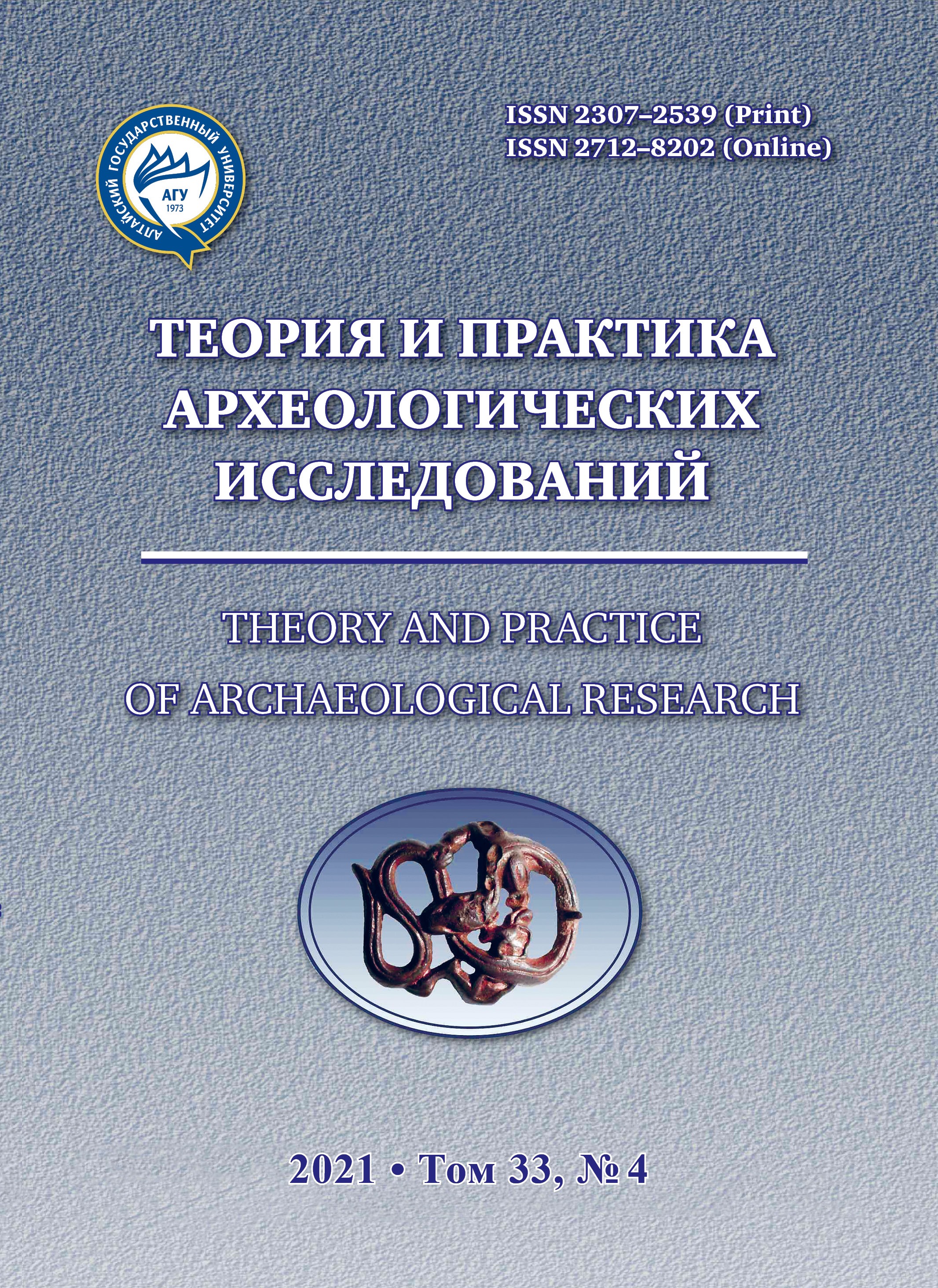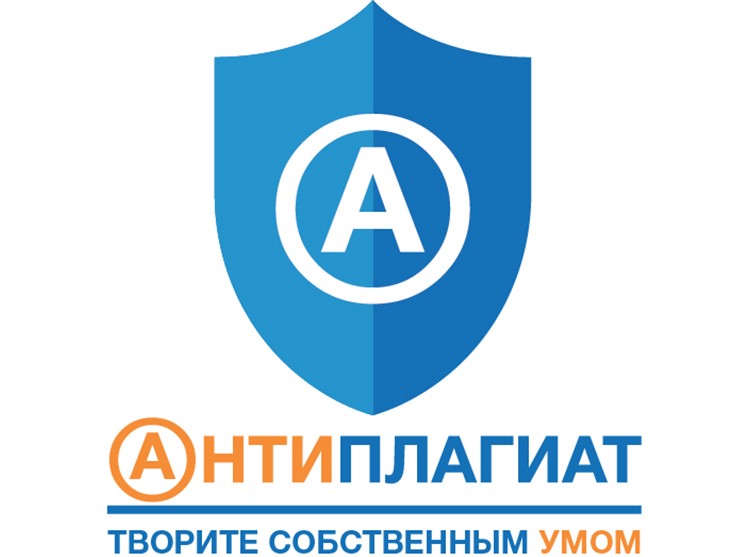On the Functional Purpose of the Seyma-Turbino Bronze Spearheads With a Hook
Abstract
Spear, “rogatina”, was an effective tool to hunt bears, elks and wild boars. To stop the attack of a massive animal, people used various devices strengthened on the bushing. On the Seyma-Turbino fork spears found in Western Siberia, the hook located under the nib could also serve as one of the variants of such devices. The initial design flaw of such products was the fork located at the level (or above) of the connection line of the bushing with the nib. This is how the spearheads were modeled in the Rostovka burial ground, as well as in the Pyshminskaya and Priirtyshskaya collections. In the metallurgical traditions of Eastern Europe, the fork was replaced by a rhombic rhombic nib rod. On the territory of Western Siberia, starting from the original leaf-like shape of the forked tips, the Seima-Turbino craftsmen began to make specialized Theory and practice of archaeological research samples with a reinforced connection of a the bushing and a narrow feather. The relatively later appearance of forked spearheads with a narrow nib and a modified fork was most likely due to their main functional purpose - hunting.
Downloads
Metrics
No metrics found.
References
Bader O.N. Oldest Metallurgists of the Urals. Moscow : Nauka, 1964. 176 p. (In Russ.)
Bader O.N. Ok Basin in the Bronze Age. Moscow : Nauka, 1970. 176 p. (In Russ.)
Bobrov V.V. Samus-Seuma bronzes products of the Kuznetsk basin. Archeologiya, ethnografiya i antropologiya Evrasii = Archaeology, Ethnography and Anthropology of Eurasia. 2000;1:76–79. (In Russ.)
Bobrov L.A., Filippovich Yu.A. Spearhead with S-shaped “Otrozhki” from the Suzgun District of the Novosibirsk Region. Vestnik Novosibirskogo gosudarstvennogo universiteta = Bulletin of Novosibirsk State University. 2015;14(3):93–99. (In Russ.)
Borodovskij A.V., Oborin Yu.V. Objects of the Seyma-Turbino Metal Complex from Nizhny Pyshma. Vestnik Novosibirskogo gosudarstvennogo universiteta = Bulletin of Novosibirsk State University. 2020;19(5):103–118. (In Russ.) DOI 10.25205/1818-7919-2020-19-5-103-118
Winkler P.P. von. Weapons. Guide to the History, Description and Depiction of Hand Weapons from Ancient Times to the Beginning of the 19th Century. Moscow : Soft-Master, 1992. 330 p. (In Russ.)
Grushin S.P. Tips of Copies of the Seyma-Turbino Type of the Ob-Irtysh Interfluves. Kul’tury stepnoj Evrazii i ih vzaimodejstvie s drevnimi civilizaciyami = Cultures of Steppe Eurasia and Their Interaction with Ancient Civilizations. Sankt-Petersburg : Periferiya, 2012. V. 2. Pp. 224–229. (In Russ.)
Dal’ V.I. Glossary of Russian Living Language. Sankt-Petersburg : Tip. M.O. Wolfa, 1882. V. 4. 704 p. (In Russ.)
Dvurechenskij O.V. Cold Weapons of the Moscow State of the 15th –17th Centuries. Tula : Gosudarstvennyj muzej-zapovednik “Kulikovo Pole”, 2014. 536 p. (In Russ.)
Ilyushin B.A. Tips of the Rogatin from Collection of the Nizhegorodsk Historical and Architectural Museum-Reserve. Vestnik Novosibirskogo gosudarstvennogo unversiteta = Bulletin of Novosibirsk State University. 2019;18(5):146–153. (In Russ.) DOI 10.25205/1818-7919-2019-18-5-146-153
Kiryushin Yu.F. Eneolithic and Early Bronze Age of the South of Western Siberia. Barnaul: Izd-vo Alt. un-ta, 2002. 294 p. (In Russ.)
Klyashtornyj S.G., Savinov D.G. Sanctuary of Nariin Hurumta: Ancient Europeans in the Center of Asia. Archeologiya, ethnografiya i antropologiya Evrasii = Archaeology, Ethnography and Anthropology of Eurasia. 2004;3(19):87–97. (In Russ.)
Kovtun I.V. Prehistory of Indo-Aryan Mythology. Kemerovo : ASIA-PRINT, 2013. 702 p. (In Russ.)
Kozhin P.M. Siberian Phalanx of the Bronze Age. Voennoe delo naseleniya yuga Sibiri i Dal’nego Vostoka = Military Affairs of the Population of the South of Siberia and the Far East. Novosibirsk : Nauka, 1993. Pp. 16–40. (In Russ.)
Kosarev M.F. Bronze Age of the Western Siberia. Moskow : Nauka, 1981. 271 p. (In Russ.)
Xenophont. Compositions in 5 Issues / translate Greek G.A. Yanchevetsky. Mitava : Tip. I.F. Steffenhagena i syna, 1876–1880. (In Russ.)
Kuzminyhe S.V. Seyma-Turbino Problem: New Materials. Kratkie soobsheniya Instituta arheologii = Brief Reports of the Institute of Archaeology. 2011;225:240–262. (In Russ.)
Maznichenko A.P. Bronze Tip of the Spear from the Kostanay Museum. Eneolit i bronzovyj vek Uralo-Irtyshskogo mezhdurech’ya = Eneolithic and Bronze Age of the Ural-Irtysh interfluve. Chelyabinsk : Izd-vo Bashkir. un-ta, 1985. Pp. 152–154. (In Russ.)
Malov O.L. Hunting Cold Weapons. Moscow : Aquarium-Print, 2005. 287 p. (In Russ.)
Marchenko Zh.V., Svyatko S.V., Grushin A.E., Rykun M.P. Radiocarbon Sates and Chronology of the Rostovka Bural Ground (Omsk Irtysh). Trudy V (XXI) Vserossijskogo s”ezda v Barnaule–Belokurihe = Proceeding V (XXI) of the All-Russian archaeological Congress in Barnaul–Belokuricha. Barnaul : Izd-vo Alt. un-ta, 2017. Vol. 1. Pp. 287–291. (In Russ.)
Matyushchenko V.I., Sinicyna G.V. Burial ground near the Village of Rostovka near Omsk. Tomsk : Izd-vo Tom. un-ta, 1988. 136 p. (In Russ.)
Medvedkov N. Hunting 2300 Years Ago. Russkij ohotnik = Russian hanter. 1892;94:8 (In Russ.)
Mel’nickij N.A. Bears and Bear Hunting. Ohota na medvedya: sbornik 3 knig po ohote =Bear Hunting. Collection of 3 Books on Hunting. Moscow : Izd-vo IP Sekachev V.Yu., 2017. 338 p. (In Russ.)
Molodin V.I. Burial of the Foundryman from the Burial Ground Sopka-2. Drevnie gornyaki i metallurgi Sibiri = Ancient Miners and Metallurgists of Siberia. Barnaul : Izd-vo Alt. unta, 1983. Pp. 96–108. (In Russ.)
Molodin V.I. Seyma-Turbino Bronzes in Closed Complexes of the Odino Culture (Barabinskaya forest-steppe). Fundamental’nye problemy arheologii, antropologii i etnografii Evrazii: K 70-letiyu akademika A.P. Derevyanko = Fundamental Problems of Archaeology, Anthropology and Ethnography of Eurasia: to the 70th Anniversary of Academician A.P. Derevyanko. Novosibirsk : Izd-vo In-ta arheologii i etnografii SO RAN, 2013. Pp. 309–324. (In Russ.)
Molodin V.I., Durakov I.A., Sofejkov O.V., Nenahov D.A. Bronze Celt of Turbine Type from Central Baraba. Problemy arheologii, etnografii i antropologii Sibiri i sopredel’nyh territorij Problems of Archaeology, Ethnography, Antropology of Siberia and Adjacent Territories. Novosibirsk : Izd-vo In-ta arheologii i etnografii SO RAN, 2012. Vol. 18. Pp. 226–230. (In Russ.)
Molodin V.I., Neskorov A.V. Collection of Seyma-Turbino Bronzes from the Irtysh Region (the tragedy of a unique site — the consequences of the Grave Robbery of the XXI century). Archeologiya, ethnografiya i antropologiya Evrasii = Archaeology, Ethnography and Anthropology of Eurasia. 2010;3(43):58–71. (In Russ.)
Molodin V.I., Chemyakina A.M., Pozdnyakova O.A. Archeological-geophysical Studies of the Preobrazhenka-6 Site in the Barabinsky Forest-steppe. Problemy arheologii, etnografii i antropologii Sibiri i sopredel’nyh territorij = Problems of Archaeology, Ethnography, Antropology of Siberia and adjacent Territories. Novosibirsk : Izd-vo In-ta arheologii i etnografii SO RAN, 2012. Vol. 13. Pp. 339–344 (In Russ)
Moshinskaya V.I. The Question about the Role of South Component in the Culture Fare North and Western Siberia. Etnokul’turnaya istoriya naseleniya Zapadnoj Sibiri = Etnocultural History of Western Siberia. Tomsk : Izd-vo Tomsk. un-ta, 1978. Pp. 56–72. (In Russ.)
Savinov D.G. On two Ways of Distribution of Bronze Products of Seyma Type to the East. Teoriya I praktika arheologicheskih issledovanij = Theory and Practice of Archaeological Research. 2013;8(2):5–16. (In Russ.)
Tishkin A.A., Semibratov V.P. Bronze Spearhead from Novikovo (Biya district of Altai region). Sohranenie i izuchenie kul’turnogo naslediya Altajskogo kraya = Preservations and Study of Cultural Heritage of the Altai Territory. Barnaul : Izd-vo Alt. un-ta, 2013. Vyp. XVIII–XIX. Pp. 252–255. (In Russ.)
Umanskij A.P., Demin M.A. Tips of Copies of the Seyma-Turbino Type in Altai. Drevnie gornyaki i metallurgi Sibiri = Ancient Miners and Metallurgists of Siberia. Barnaul : Izd-vo Alt. un-ta, 1983. Pp. 143–150. (In Russ.)
Hudyakov Yu.S., Belinskaya K.I. Spear as a Weapon, a Symbol of Power and Military Organization among the Ancient Nomads of the Eurasian Steeps. Andronovskij mir = Andronovo world: a collection of articles. Tyumen’ : Izd-vo Tyumen. un-ta, 2010. Pp. 49–44. (In Russ.)
Chernyh E.N. From the Metallurgy of the Tribes of the Bronze Age in the Volga Region and the Ural. Pamyatniki epohi bronzy yuga evropejskoj chasti SSSR = Monuments of the Bronze Age of the South of the European Part of the USSR. Kiev : Naukova dumka, 1967. Рp. 195–213. (In Russ.)
Chernyh E.N., Kuzminyh S.V. Ancient Metallurgy of Northern Eurasia. Moscow : Nauka, 1989. 320 p. (In Russ.)
Theory and Practice of Archaeological Research is a golden publisher, as we allow self-archiving, but most importantly we are fully transparent about your rights.
Authors may present and discuss their findings ahead of publication: at biological or scientific conferences, on preprint servers, in public databases, and in blogs, wikis, tweets, and other informal communication channels.
Theory and Practice of Archaeological Research allows authors to deposit manuscripts (currently under review or those for intended submission to ABS) in non-commercial, pre-print servers such as ArXiv.
Authors who publish with this journal agree to the following terms:
- Authors retain copyright and grant the journal right of first publication with the work simultaneously licensed under a Creative Commons Attribution License (CC BY 4.0) that allows others to share the work with an acknowledgement of the work's authorship and initial publication in this journal.
- Authors are able to enter into separate, additional contractual arrangements for the non-exclusive distribution of the journal's published version of the work (e.g., post it to an institutional repository or publish it in a book), with an acknowledgement of its initial publication in this journal.
- Authors are permitted and encouraged to post their work online (e.g., in institutional repositories or on their website) prior to and during the submission process, as it can lead to productive exchanges, as well as earlier and greater citation of published work (See The Effect of Open Access).








2.jpg)




